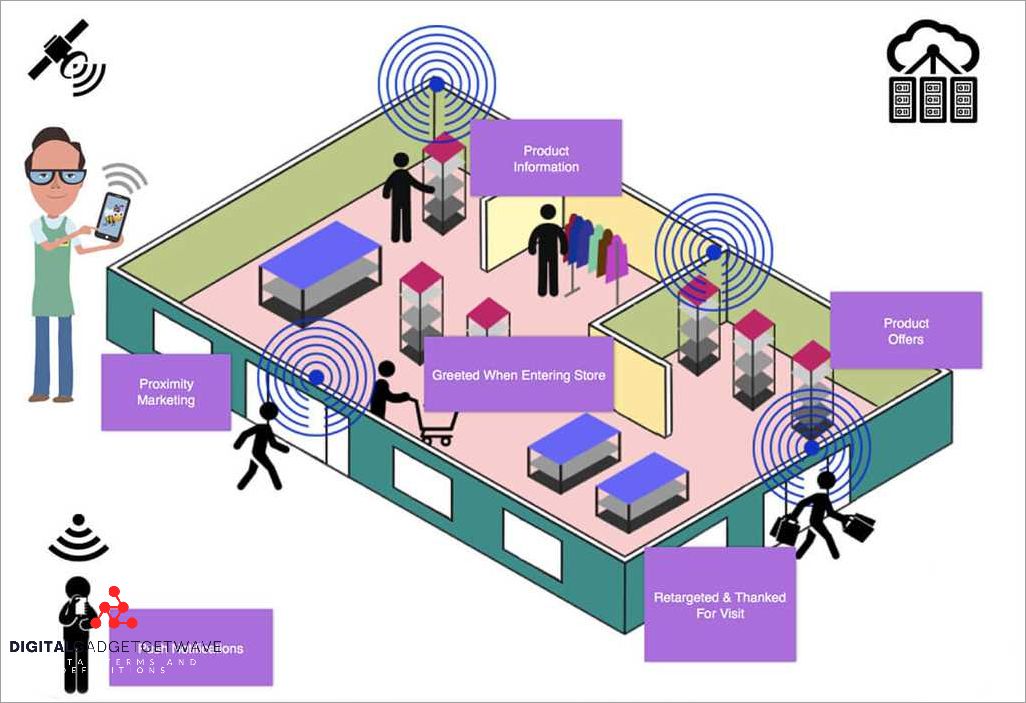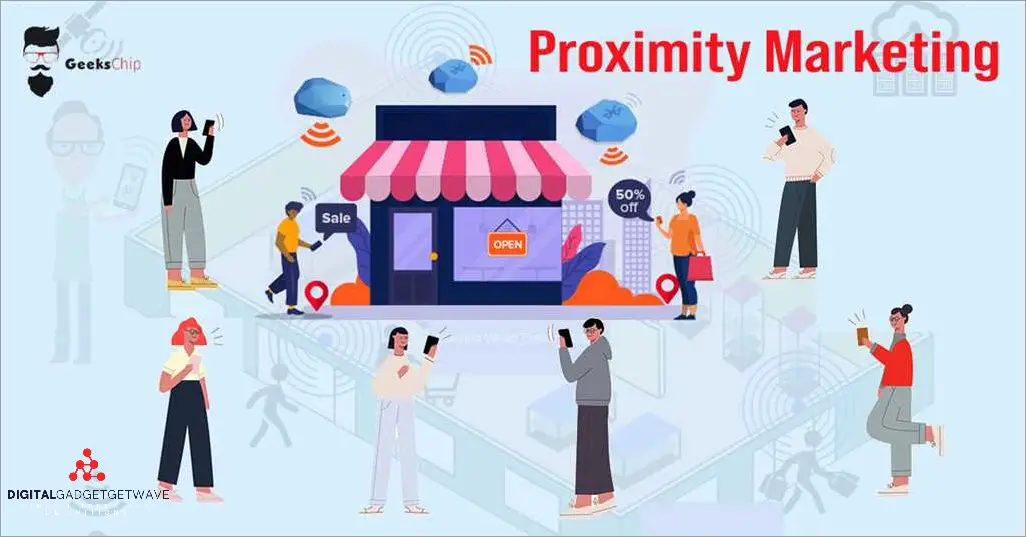
Proximity marketing is a mobile communication strategy that focuses on advertising to customers based on their location. This location-based marketing approach uses proximity technology such as geo-fencing and targeted messaging to reach customers when they are in close proximity to a specific location.
The key feature of proximity marketing is the use of devices such as beacons, which emit signals that can be detected by nearby smartphones. When a customer’s device comes within range of the beacon, it triggers a targeted notification or message that is delivered to the customer’s device. This targeted engagement allows retailers and businesses to deliver personalized offers, discounts, and promotions directly to the customer, increasing the chances of a successful conversion.
Proximity marketing has revolutionized the way businesses engage with customers. By leveraging the power of proximity-based targeting, businesses can create highly relevant and personalized experiences for their customers. The technology enables businesses to understand customer behavior and preferences based on their location, allowing them to tailor their marketing efforts accordingly.
Contents
- 1 What is Proximity Marketing?
- 2 How Does Proximity Marketing Work?
- 3 Benefits of Proximity Marketing
- 4 FAQ about topic “Understanding Proximity Marketing: A Guide to How it Works”
- 5 What is proximity marketing?
- 6 How does proximity marketing work?
- 7 What are the benefits of proximity marketing?
- 8 What technologies are used in proximity marketing?
- 9 Can proximity marketing be intrusive?
What is Proximity Marketing?
Proximity marketing is a location-based marketing strategy that uses mobile devices to engage customers in targeted advertising and promotion. It involves the use of technology such as beacons and geo-fencing to communicate with customers in close proximity to a retail location.
By utilizing this proximity-based targeting, retailers can deliver personalized and contextual messages to their customers, increasing the chances of customer engagement and conversion. Beacons, small devices that transmit signals, are often used to detect the customer’s location and deliver relevant marketing content to their mobile devices.
One of the key benefits of proximity marketing is its ability to provide real-time communication with customers, allowing retailers to send timely and relevant offers based on the customer’s current location. This targeted approach helps to enhance customer experience and increase the likelihood of making a purchase.
Geo-fencing is another technology commonly used in proximity marketing. It allows retailers to create virtual boundaries around a specific location, such as a store or event venue, and send notifications or offers to customers who enter or exit the designated area.
Overall, proximity marketing offers a unique and effective way for retailers to engage with their customers by delivering personalized and targeted messages based on their location. This technology-driven approach enhances customer experience, increases brand awareness, and improves marketing ROI.
Definition of Proximity Marketing

Proximity marketing is a targeted marketing strategy that uses location-based technology to communicate with customers in close proximity to a retail location. By leveraging mobile devices and proximity-based technologies like beacons, proximity marketing allows businesses to target specific customers and promote their products or services.
Proximity marketing works by setting up geo-fencing or location-based boundaries around a specific area, such as a store or event venue. When customers enter this designated location, their mobile devices receive signals from nearby beacons or other devices, triggering targeted advertising or promotional messages.
The main purpose of proximity marketing is to enhance communication and engagement with customers in real-time, providing them with relevant and personalized offers or information. By leveraging the proximity-based technology, businesses can deliver targeted messages to customers based on their location and preferences, increasing the likelihood of a successful sale or conversion.
Proximity marketing has become increasingly popular in the retail industry, as it offers a cost-effective way to reach customers at the right place and time. By using proximity marketing, businesses can deliver personalized and timely promotions directly to their target audience, improving customer satisfaction and driving sales.
How Does Proximity Marketing Work?
Proximity marketing is a retail strategy that utilizes beacon technology to engage and communicate with customers in a location-based and targeted manner. By using small devices called beacons, businesses can create an interactive and personalized shopping experience for their customers.
The location-based aspect of proximity marketing is achieved through the use of geo-fencing. Geo-fencing allows businesses to define a virtual boundary around a specific area, such as a retail store. When customers enter this boundary with their mobile devices, they receive notifications and promotions relevant to their location.
Beacons, which are small and wireless devices, transmit signals to nearby mobile devices via Bluetooth technology. These signals contain information about the business and its products or services. When a customer approaches a beacon, their mobile device detects the signal and can deliver targeted advertising or other forms of engagement to the customer.
Proximity marketing is an effective strategy because it allows businesses to deliver personalized and relevant content to customers at the right time and place. By understanding the customer’s location and preferences, businesses can tailor their promotions and communications to provide a more engaging and satisfying experience.
In summary, proximity marketing utilizes beacon technology to target customers based on their location and deliver personalized promotions and engagement. By taking advantage of the capabilities of mobile devices and geo-fencing, businesses can create a customized and interactive shopping experience for their customers.
Types of Proximity Marketing Technologies

Proximity marketing utilizes various technologies to target customers based on their location and proximity to specific areas or devices. These technologies can be implemented in different settings, such as retail stores, restaurants, or outdoor events, to deliver personalized marketing messages and promotions to customers. Here are some commonly used proximity marketing technologies:
- Geo-fencing: This technology involves setting up virtual boundaries or perimeters around a specific location or area. When customers enter or exit these boundaries, they can receive targeted marketing messages or promotions on their mobile devices.
- Beacons: These small devices use Bluetooth technology to communicate with customers’ mobile devices when they are within a certain range. Beacons can be placed strategically throughout a store or venue to provide location-based offers and information to customers.
- Location-based mobile apps: Mobile apps can utilize the location services on customers’ devices to deliver relevant marketing messages and promotions based on their current location. These apps can also track customer behavior and preferences to further personalize the marketing experience.
- Proximity-based advertising networks: Advertising networks can leverage proximity marketing technologies to deliver targeted ads to customers based on their proximity to certain locations or devices. These ads can be displayed on websites, mobile apps, or other digital platforms.
- Customer engagement platforms: These platforms enable businesses to engage with customers in real-time through various communication channels, such as SMS, push notifications, or email. By analyzing customer data and behavior, businesses can deliver personalized messages and offers to enhance the customer experience.
Overall, proximity marketing technologies offer businesses a powerful tool to target and engage with customers in a more personalized and location-specific way. By leveraging these technologies as part of their marketing strategy, businesses can deliver relevant promotions and messages to their customers, increasing customer engagement and ultimately driving sales.
Examples of Proximity Marketing Campaigns
Proximity marketing campaigns utilize mobile devices and location-based technology to engage with customers in a targeted and personalized manner. With the use of geo-fencing and beacons, businesses can create effective proximity marketing strategies to enhance customer communication and drive sales.
One example of a proximity marketing campaign is the use of beacons in retail stores. These small devices can be placed throughout the store and connect with customers’ mobile devices when they come within close proximity. By sending targeted promotions and advertising directly to customers’ phones, businesses can increase engagement and drive sales. For example, a clothing store might send a notification about a special discount on jeans as a customer walks by the denim section.
Another example of proximity marketing is the use of location-based targeting at events or conferences. By setting up geo-fences around the venue, businesses can send relevant information and promotions to attendees’ mobile devices. For instance, a technology company exhibiting at a trade show might send a notification about a special product demonstration happening in their booth, increasing the likelihood of attracting interested participants.
In the hospitality industry, proximity marketing can be used to enhance the guest experience. Hotels can utilize beacons to send information about amenities, offers, and promotions to guests’ mobile devices when they are in certain areas of the hotel. This targeted approach allows hotels to provide personalized recommendations and improve customer satisfaction.
In summary, proximity marketing campaigns utilize mobile devices, geo-fencing, and beacon technology to engage customers with targeted advertising and promotions. This location-based strategy enhances customer communication and drives sales in various industries, including retail and hospitality.
Benefits of Proximity Marketing
Proximity marketing, also known as location-based marketing, utilizes geo-fencing and beacon technology to deliver targeted promotions to mobile devices. This innovative form of advertising offers several benefits for both businesses and customers.
- Increased customer engagement: Proximity marketing allows businesses to engage with customers in real-time by sending relevant promotions based on their current location. This personalized approach enhances customer experience and increases the likelihood of conversion.
- Improved customer targeting: By leveraging proximity-based technology, businesses can target their promotions to customers who are in close proximity to their retail locations or specific areas. This helps in reaching the right audience and maximizing the impact of advertising campaigns.
- Enhanced customer experience: Proximity marketing enables businesses to provide personalized and contextually relevant promotions to customers. This not only improves the overall customer experience but also increases customer satisfaction and loyalty.
- Increased foot traffic: By attracting nearby customers with targeted promotions, proximity marketing can drive traffic to physical retail locations. This can result in increased sales, as customers are more likely to make a purchase when they are physically present at the store.
- Improved marketing ROI: Proximity marketing allows businesses to track the effectiveness of their advertising campaigns in real-time. By analyzing customer response and engagement metrics, businesses can optimize their marketing strategies and maximize their return on investment.
In conclusion, proximity marketing offers numerous benefits for businesses, including increased customer engagement, improved targeting, enhanced customer experience, increased foot traffic, and improved marketing ROI. By leveraging location-based technology and targeted promotions, businesses can effectively reach and engage with customers, ultimately driving sales and business growth.
Increased customer engagement
Proximity marketing leverages the location-based capabilities of mobile devices to deliver targeted marketing messages to customers in specific locations. By using proximity-based technologies like beacons and geo-fencing, businesses can send promotions and notifications directly to customers’ smartphones when they are in close proximity to a retail location.
This targeted approach to marketing allows businesses to engage customers in a more personalized and relevant way. By delivering messages that are tailored to a customer’s location, businesses can provide highly targeted offers and discounts that are more likely to resonate with the customer’s current needs and interests.
Proximity marketing also enables businesses to enhance communication and engagement with their customers. Through location-based promotions, businesses can encourage customer interaction, such as checking in to a store or participating in a loyalty program. This not only increases customer engagement but also provides valuable data and insights that can be used to further refine the marketing strategy.
In the retail industry, proximity marketing has the potential to revolutionize the customer experience. By utilizing proximity-based technologies, businesses can create a more seamless and personalized shopping experience. For example, a customer walking through a store can receive real-time notifications about relevant products or exclusive discounts, making their shopping experience more efficient and enjoyable.
This technology-driven approach to marketing offers businesses the ability to reach customers at the right time and place, making their marketing efforts more effective. Increased customer engagement through proximity marketing can lead to higher customer satisfaction, increased brand loyalty, and ultimately, improved sales and business growth.
Higher conversion rates
Proximity marketing has the power to significantly increase conversion rates through targeted engagement. By leveraging proximity-based marketing technology, businesses can reach customers based on their location and deliver personalized promotions that are highly relevant and timely.
Using beacons or other location-based devices, businesses can send targeted advertising messages or promotional offers directly to customers’ mobile devices when they are in close proximity to a physical store or a specific location. This proximity-based communication allows for a more personalized and tailored approach to marketing, increasing the chances of converting customers.
By utilizing proximity marketing as part of their advertising strategy, businesses can implement geo-fencing techniques to create virtual boundaries around specific locations. This technology allows businesses to target customers within a certain distance from their store or event and send them promotional messages or notifications to attract them to the location.
Proximity marketing enables businesses to engage with customers in a highly targeted and personalized manner, increasing the likelihood of conversion. By delivering relevant and timely promotions based on a customer’s location, businesses can capture their attention and entice them to make a purchase or take a desired action.
Furthermore, the use of proximity marketing technology allows for real-time communication and interaction with customers. Businesses can gather data on customer preferences and behavior, enabling them to refine their marketing strategies and deliver even more targeted and effective promotions in the future. This data-driven approach to marketing ensures that businesses can optimize their conversion rates and maximize their return on investment.
In conclusion, proximity marketing offers businesses the opportunity to increase their conversion rates through targeted engagement and personalized promotions. By leveraging location-based technology and delivering relevant messaging to customers’ mobile devices, businesses can capture their attention and influence their purchasing decisions. Additionally, the ability to gather data on customer behavior allows for continuous improvement and optimization of marketing strategies, ultimately leading to higher conversion rates.
Improved customer targeting
Proximity marketing technology, such as beacons, allows businesses to target specific customers with relevant content and offers based on their location and proximity to the store. By using targeted communication and engagement strategies, businesses can deliver personalized advertising and promotions to customers’ mobile devices.
One of the key benefits of proximity marketing is its location-based targeting capabilities. By leveraging the proximity-based features of beacons, businesses can create geo-fencing and location-based promotions. This allows them to deliver targeted messages and offers to customers who are physically near their store or in a specific location.
With proximity marketing, businesses can refine their targeting strategy by understanding customer behavior and preferences. By analyzing customer data and interactions, businesses can gain insights into what kind of promotions and offers are most effective for different customer segments. This enables businesses to tailor their marketing efforts towards individual customers and maximize the effectiveness of their advertising campaigns.
Proximity marketing also allows businesses to improve customer engagement by delivering relevant content at the right time and place. By sending personalized messages and offers to customers’ mobile devices when they are near or in-store, businesses can increase the likelihood of customer interaction and conversion. This targeted approach enhances the overall customer experience and fosters a deeper connection between the customer and the brand.
Overall, proximity marketing enables businesses to improve their customer targeting by leveraging location-based technology and targeted communication strategies. By delivering personalized advertising and promotions to customers’ mobile devices based on their proximity to the store, businesses can enhance customer engagement and drive more effective marketing campaigns.
FAQ about topic “Understanding Proximity Marketing: A Guide to How it Works”
What is proximity marketing?
Proximity marketing is a location-based marketing strategy that uses a combination of technologies such as beacons, GPS, and mobile devices to deliver personalized and targeted messages to customers when they are in close proximity to a physical location or point of interest.
How does proximity marketing work?
Proximity marketing works by using devices such as beacons that emit signals to nearby mobile devices. When a person’s mobile device receives the signal, it can trigger a notification or message to be displayed on their device. This message can contain promotional offers, discounts, or relevant information related to the specific location or business.
What are the benefits of proximity marketing?
Proximity marketing offers several benefits for businesses. It allows for personalized and targeted messaging, which can result in higher conversion rates and increased customer engagement. It also helps businesses gather data and insights about customer behavior and preferences, which can be used to improve marketing strategies and tailor offers to individual customers.
What technologies are used in proximity marketing?
Proximity marketing relies on various technologies, including Bluetooth Low Energy (BLE) beacons, Near Field Communication (NFC), GPS, and mobile devices. BLE beacons are commonly used to emit signals to nearby mobile devices, while NFC can enable contactless communication between devices. GPS is used to determine the location of the mobile device, and mobile devices themselves are the primary channels for delivering messages to users.
Can proximity marketing be intrusive?
Proximity marketing has the potential to be intrusive if not implemented properly. Bombarding customers with too many notifications or irrelevant messages can be annoying and lead to a negative user experience. However, when used strategically and with respect for customer preferences, proximity marketing can be an effective and non-intrusive way to engage with customers and provide them with valuable information and offers.


